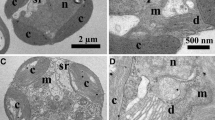Summary
The extrusive apparatus is the most prominent and complex structure of epixenosomes. In the present paper the mechanisms activating its ejecting process were investigated by means of in vivo treatments and cytochemical procedures at the ultrastructural level. The results obtained clearly demonstrated that the ejecting process in epixenosomes is triggered by the detection of external signals through membrane receptors and the consequent activation of the adenylate cyclase-cyclic AMP system as a transduction mechanism. The membrane receptors coming into play have an affinity for soybean agglutinin and have a precise localization at the top of the organism, just where a membrane interruption appears as a first step in the whole process. The factors that trigger ejection in nature are still unknown. In the laboratory, ejection was obtained in the presence of adrenalin, which has been proved to bind to the same receptors shown to have affinity for soybean agglutinin. So epixenosomes appear to possess specific binding molecules for a mammalian hormone in the appropriate location, i.e., in the plasma membrane, and this hormone induces a precise biological response. These results are particularly interesting if we consider that epixenosomes are enigmatic organisms in which prokaryotic and eukaryotic characteristics appear to coexist.
Similar content being viewed by others
Abbreviations
- AC:
-
adenylate cyclase
- BSA:
-
bovine serum albumin
- cAMP:
-
cyclic adenosine monophosphate
- Con A:
-
concanavalin A
- DAB:
-
diamino benzidin tetrahydrochloride
- DZ:
-
dome-shaped zone
- EA:
-
extrusive apparatus
- PBS:
-
phosphate buffered saline solution
- SB:
-
soybean agglutinin
- SEM:
-
scanning electron microscope
- TEM:
-
transmission electron microscope
- WGA:
-
wheat germ agglutinin
References
Anderson E (1962) A cytological study ofChilomonas paramecium with particular reference to the so-called trichocysts. J Protozool 9: 380–394
Botsford JL, Harman JG (1992) Cyclic AMP in prokaryotes. Microbiol Rev 56: 100–122
Cohen KL, Bitensky MW (1969) Inhibitory effects of alloxan on mammalian adenyl cyclase. J Pharmacol Exp Ther 169: 80–86
Csaba G (1985) The unicellularTetrahymena as a model cell for receptor research. Int Rev Cytol 95: 327–377
De Castro SL, Luz MRMP (1993) The second messenger cyclic 3′, 5′-adenosine monophosphate in pathogenic microorganisms with special reference to protozoa. Can J Microbiol 39: 473–479
Doehler KD (1986) Development of hormone receptors. Experientia 42: 788–794
Giambelluca MA, Rosati G (1996) The behavior of epixenosomal band during morphogenesis inEuplotidium itoi. Eur J Protistol 21: 77–80
Hovasse R, Mignot JP, Joyon L (1967) Nouvelles observations sur les trichocystes des cryptomonadines et les “R bodies” des particules kappa deParamecium aurelia killer. Protistologica 3: 241–255
Lenard J (1992) Mammalian hormones in microbial cells. Trends Biochem Sci 17: 147–150
Preer JR, Preer LB, Jurand A (1974) Kappa and other endosymbionts inParamecium aurelia. Bacteriol Rev 38: 113–163
Rosati G, Verni F (1991) Sexual recognition in protozoa: chemical signals and transduction mechanisms. Zool Sci 8: 415–429
—, Lenzi P, Verni F (1993a) “Epixenosomes”: peculiar epibionts of the protozoon ciliateEuplotidium itoi: do their cytoplasmic tubules consist of tubulin? Micron 5: 465–471
—, Verni F, Lenzi P (1993b) “Epixenosomes”: peculiar epibionts of the ciliateEuplotidium itoi. The formation of the extrusive apparatus and the ejecting mechanism. Eur J Protistol 29: 238–245
—, Giambelluca MA, Taiti E (1996) Epixenosomes: peculiar epibionts of the ciliateEuplotidium itoi: morphological and functional cell compartmentalization. Tissue Cell 28: 313–320
Verni F, Rosati G (1990) Peculiar epibionts inEuplotidium itoi (Ciliata, Hypotrichida). J Protozool 36: 113–119
Author information
Authors and Affiliations
Rights and permissions
About this article
Cite this article
Rosati, G., Giambelluca, M.A., Grossi, M. et al. Epixenosomes, peculiar epibionts of the ciliateEuplotidium itoi: Involvement of membrane receptors and the adenylate cyclase-cyclic AMP system in the ejecting process. Protoplasma 197, 57–63 (1997). https://doi.org/10.1007/BF01279884
Received:
Accepted:
Issue Date:
DOI: https://doi.org/10.1007/BF01279884




